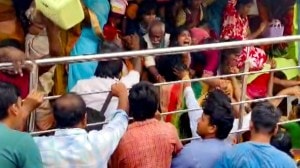Chidambaram calls for private participation in nuclear power industry
MUMBAI, APR 21: In tune, per se, with the ongoing reform process and liberalisation of the Indian economy, Dr R Chidambaram, Chairman, At...

MUMBAI, APR 21: In tune, per se, with the ongoing reform process and liberalisation of the Indian economy, Dr R Chidambaram, Chairman, Atomic Energy Commission (AEC) and Secretary, Department of Atomic Energy (DAE), called for private participation in the nuclear power industry.
Noting that the coming millennium will witness Asia emerge as centrestage in nuclear power production with the continent accounting for three quarters of the increase in global nuclear capacity, Chidambaram said that India had the technological capability and the infrastructure to stake a claim in meeting the increasing demand for cheap nuclear power. If it’s programme was limited in any way, it was only because of funds crunch, with the budgetary support inadequate to keep pace with the demand. Hence the necessity of attracting private capital to fill the gap between the capacity to supply nuclear power and the burgeoning demand for it.
Chidambaram was delivering the address inaugurating an international seminar onNuclear Power in 21st Century — Challenges and Opportunities on Wednesday at the Bhabha Atomic Research Centre in North-East Mumbai. The seminar was organised as part of the celebrations to mark 100 years of thermal power generation in India.
If the target of producing 20,000 MW of installed capacity was to be met by the year 2020, India needed about Rs 80,000 crore. Since, the needed capital cannot be covered by budgetary support alone, there was no option but to go in for private capital, he said.
Chidambaram stressed the need for a proper statutory framework was essential to make the proposal workable and added that the private nuclear plants so set up would "be subject to the same strict regulatory framework as are the plants operated by NPCIL (Nuclear Power Corporation of India Limited)".
However, this position elicited a curious set of responses at the press conference held after the inaugural. When pointedly asked, given the dual use of civilian power reactors in terms of obtainingplutonium and tritium as by-products, whether private participation would compromise security concerns, Chidambaram cited the American experience and went on to assert that critical areas would be under the direct control of the appropriate regulatory body. Even as Chidambaram ended his answer, NPCIL Chairman and Managing Director Y S R Prasad, spoke up to deny that the civilian power reactors had "dual" uses. The responses, in contrast, had their own irony. For, Prasad later waxed eloquent on how he had initiated a system of complete transparency particularly in relation to safety-related issues as they applied to civilian nuclear reactors.
Both Chidambaram and Prasad went on to explain at length that the safety standards were impeccable, and when event of "no safety significance" ( zero in the International Nuclear Event Scale) like the recent MAPS-2 reactor heavy water leak took place, a corrective mechanism automatically was deployed to study and obviate any such future nuclear events.
Earlier at theinaugural address, Chidambaram rubbished proliferation implications in developing India’s nuclear power capacity by quoting John Ritch, US ambassador to the UN organisations un Vienna who said that India and China were "irrelevant to the proliferation concern, having already acquired the relevant capabilities".
Prasad, while delivering the presidential address, asserted that the first stage of Indian nuclear power programme employing PHWRs had reached commercial maturity. He also revealed that currently four units of 220 MWe PHWR were being commissioned at Kaiga in Karnataka and Rawatbhata in Rajasthan and the construction of 500 MWe PHWR was started at Tarapur. Before the end of the Ninth Five Year Plan construction of two more units at Kaiga would also begin, he said, and added that six units of 500 MWe and two units of 220 MWe were awaiting sanction.



- 01
- 02
- 03
- 04
- 05




























